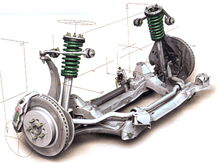
Home, Auto Repair Library, Auto Parts, Accessories, Tools, Manuals & Books, Car BLOG, Links, Index



Your car's suspension and struts is what keeps it afloat. The suspension and struts support the vehicle's weight, and allow your vehicle to glide over bumps and dips in the road. But to do this, the suspension and struts need to be in good condition.
Original equipment chassis parts on late-model cars and trucks are engineered to go 150,000 miles or more. But is that 150,000 miles of highway driving on nice smooth roads or 150,000 miles of bumps, potholes and rough roads? Nobody can say how long the suspension parts and struts on your vehicle will last because it depends on the type of driving you do. Washboard roads that give the suspension a pounding, wet weather and exposure to road salt can shorten the life of these components.
Struts (and shock absorbers) may need to be replaced if any of the following symptoms are present:
* Excessively bouncy ride
* Excessive body sway when cornering
* Excessive rocking when stopping
* Bottoming over bumps
* Nose dive when braking hard
* Cupped tire wear or high speed steering shimmy
* Fluid leaks
* Bent or damaged piston shaft
* Damaged or broken shock mountings
* Stiff steering and/or poor steering return (may indicate worn upper strut plates on MacPherson struts)
As for your vehicle's suspension, the most likely clues that parts such as ball joints, control arm bushings or tie rod ends may be worn out include:
* Uneven or rapid tire wear
* Steering play or looseness
* Suspension noise while driving or turning(clunks, thumps, squeaks)
* Steering pull to one side while driving
* A wheel that leans in or out
* Noticeable suspension sag (due to weak or broken springs)
One way to detect worn steering and suspension parts is to take your vehicle to a tire store for an alignment check. Some offer this as a free service to entice you into buying their tires. Most tire stores strongly recommend an alignment check if you are having a tire wear or steering problem. An alignment check is also recommended to protect your investment in new tires so you will get the maximum tread life.
One of the first things an alignment technician does before he checks the wheel alignment on your vehicle is inspect the steering, suspension and struts for worn or damaged parts. He should measure ball joint play, check the tie rod ends, the idler arm (if equipped), the steering gear, control arm bushings, shocks, struts and springs to see if any of these parts need to be replaced. If any problems are found, he should tell you what's wrong and what parts should be replaced.
The important point here is that the steering and suspension parts must be in good condition within normal wear limits to hold an accurate wheel alignment. Worn parts will NOT keep the wheels in proper alignment, causing increased tire wear, and poor handling.
Some parts you can replace yourself to save money, but others require professional help to install. Rebuilding a strut assembly requires a special spring compressor. It's a dangerous job best left to a pro. The other option is to buy a complete strut assembly that is already assembled with a new spring and upper bearing plate, and is ready to install. These "Quick Struts" are a real time saver. But the wheels will still have to be realigned after the struts have been replaced.
Shock absorbers are usually relatively easy to replace on vehicles that have them. The worst part is removing the nut(s) from the top of the shock, which may be rusted in place. Penetrating oil and heat from a propane torch may bee of help. An impact wrench may also be necessary.
Replacing ball joints can be difficult, especially if a joint is pressed into a control arms or has to be replaced as part of the control arm. The same goes for control arm bushings. They can be fairly difficult to press into place. Wheel alignment is also necessary after replacing a ball joint, control arm or control arm bushing.
Coil springs may require a spring compressor to remove and install, but leaf springs can usually just be unbolted. Again, rusty bolts can really slow things down if you have to remove U-bolts on a rear axle to replace a leaf spring.
Tie rod ends unscrew from the tie rods, but may also be rusted in place. Heat and penetrating oil are your main helpers for this type of job. Counting the number of turns a tie rod spins around before it comes off may help you position the new tie rod. But you should still have the tow alignment of the front wheels checked/adjusted as needed after the new parts have been installed.
 More Steering & Suspension Articles:
More Steering & Suspension Articles: Click Here to See More Carley Automotive Technical Articles
Click Here to See More Carley Automotive Technical Articles